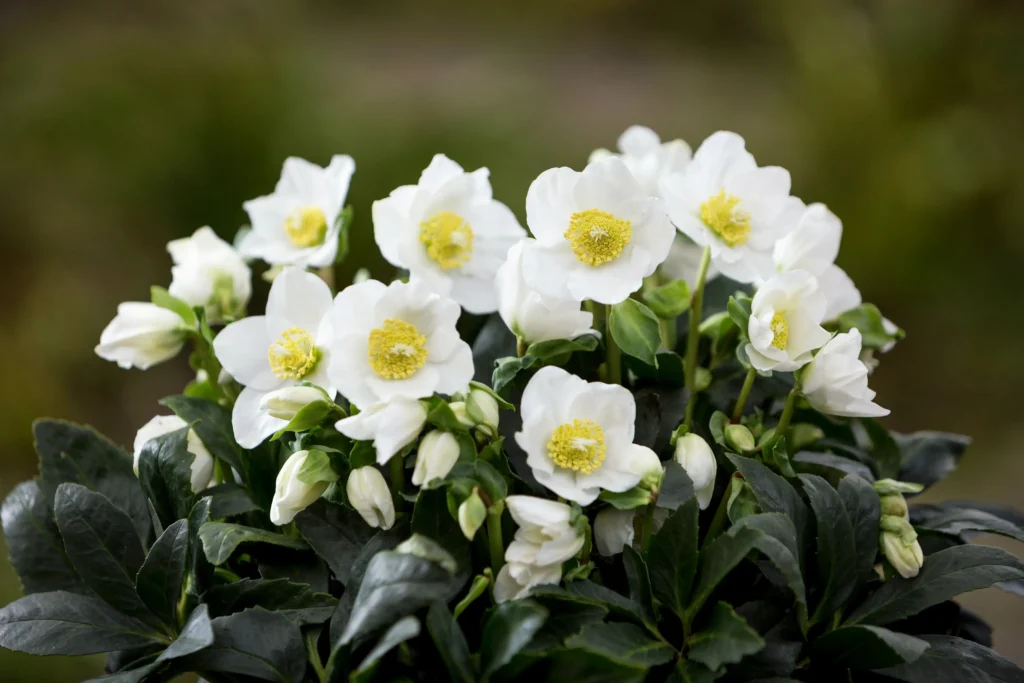Helleborus Niger, also known as the Christmas Rose or Black Hellebore, is a stunning perennial plant prized for its early winter blooms and evergreen foliage. In this comprehensive guide, we’ll explore everything you need to know to grow and care for Helleborus Niger successfully.
Care
Watering:
Helleborus Niger prefers moist, well-draining soil. Water regularly, especially during dry spells, but avoid waterlogging the soil. Adequate watering is crucial for the health and vitality of your Helleborus Niger plants. During the growing season, check the soil moisture regularly, especially during hot, dry weather. Water deeply when the top inch of soil feels dry to the touch, ensuring that the entire root zone receives moisture.
However, be cautious not to overwater, as soggy soil can lead to root rot and other moisture-related issues. In winter, reduce watering frequency, allowing the soil to dry out slightly between waterings. This helps prevent waterlogged soil, which can be detrimental to the plant’s health during the dormant season.
Sunlight:
Plant in partial shade to full shade for best results. While Helleborus Niger can tolerate some sunlight, it generally prefers shaded conditions, especially in regions with hot summers. When selecting a planting location, choose an area that receives dappled sunlight or partial shade throughout the day. Avoid planting in areas with intense, direct sunlight, particularly during the afternoon hours, as this can cause the plant’s foliage to scorch or wilt.
In regions with cooler climates, Helleborus Niger may tolerate more sun exposure, but it still benefits from some shade, especially during the hottest part of the day. Experiment with different locations in your garden to find the optimal balance of sunlight and shade for your Helleborus Niger plants.
Soil:
Choose a rich, fertile soil with good drainage. Helleborus Niger thrives in well-draining soil that is rich in organic matter. Before planting, amend heavy clay soil with compost, peat moss, or aged manure to improve drainage and fertility. Incorporating organic matter into the soil helps create a loose, crumbly texture that allows water to penetrate easily while providing essential nutrients to the plant’s roots.
Additionally, ensure that the soil pH is slightly acidic to neutral, ideally in the range of 6.0 to 7.0, for optimal growth and nutrient uptake. Perform a soil test to determine the pH level and make any necessary adjustments before planting your Helleborus Niger.
Fertilizing:
Apply a balanced, slow-release fertilizer in early spring. While Helleborus Niger is not heavy feeder, it can benefit from occasional fertilization to support healthy growth and abundant flowering. In early spring, as new growth emerges, apply a balanced, slow-release fertilizer formulated for flowering perennials according to the manufacturer’s instructions.
Avoid using high-nitrogen fertilizers, as they can promote lush foliage at the expense of flowers. Instead, choose a fertilizer with a balanced ratio of nitrogen, phosphorus, and potassium, such as 10-10-10 or 5-10-5. Apply the fertilizer evenly around the base of the plant, taking care not to allow it to come into contact with the foliage, and water thoroughly to help the nutrients reach the root zone.
Types
Single-flowered Varieties:
Single-flowered varieties of Helleborus Niger feature a single row of petals around a central boss of stamens. These classic and elegant blooms come in a range of colors, including white, cream, pink, and purple, adding a touch of charm and beauty to the winter garden. While single-flowered varieties may not have the showy double petals of their counterparts, they still make a striking statement in the landscape and are highly prized by gardeners for their simplicity and grace.

Double-flowered Varieties:
Double-flowered varieties of Helleborus Niger boast showy blooms with multiple layers of petals, creating a lush and luxurious appearance. These stunning flowers come in a wide range of colors, including deep purples, rich pinks, and creamy whites, adding a vibrant burst of color to the winter garden. Double-flowered Helleborus Niger varieties are prized for their ornamental value and are often used as focal points in garden beds, borders, and containers. With their exquisite beauty and long-lasting blooms, these varieties are sure to delight gardeners and visitors alike.
Pruning
Deadheading:
Deadheading is an essential maintenance task for Helleborus Niger plants, as it helps prolong the blooming period and keeps the plant looking tidy and attractive. As the flowers fade and begin to wilt, use a pair of sharp pruning shears to snip off the spent blooms at the base of the stem. This encourages the plant to redirect its energy into producing new flowers, resulting in a more prolonged and abundant blooming season. Deadheading also prevents the plant from self-seeding excessively, which can lead to overcrowding and reduced vigor over time. Make sure to remove any dead or yellowing foliage as well, as this helps improve air circulation around the plant and reduces the risk of fungal diseases.

Spring Pruning:
In late winter or early spring, before new growth begins, prune back any old or damaged foliage to make way for fresh, healthy growth. Using clean, sharp pruning shears, carefully trim away any dead or yellowing leaves, as well as any stems that appear weak or diseased. Be sure to cut back to healthy tissue, making clean, angled cuts to promote rapid healing and prevent the spread of disease.
Additionally, remove any debris or mulch from around the base of the plant to prevent fungal growth and pest infestations. Spring pruning helps rejuvenate the plant and encourages vigorous growth and abundant flowering throughout the growing season.
Propagating
Division:
Division is a straightforward method of propagating Helleborus Niger plants and is best done in early spring or late summer when the plant is dormant or semi-dormant. To divide an established clump of Helleborus Niger, carefully dig up the entire plant, taking care not to damage the roots. Using a sharp, clean knife or garden spade, divide the clump into smaller sections, ensuring that each division has several healthy roots and leaf buds.
Replant the divisions in well-prepared soil, spacing them at least 12 to 18 inches apart to allow for future growth. Water thoroughly after planting, and keep the soil consistently moist until the divisions establish themselves.
Root Cuttings:
Root cuttings are another effective method of propagating Helleborus Niger plants and can be taken in late summer or early autumn when the plant is actively growing. To take root cuttings, carefully dig up a portion of the plant’s root system, selecting healthy, vigorous roots for propagation. Using a sharp knife or pruners, cut the roots into sections approximately 2 to 3 inches long, ensuring that each cutting has at least one leaf bud or growth point.
Plant the root cuttings in pots filled with well-draining soil mix, burying them horizontally with the growth points facing upward. Keep the soil consistently moist and provide bottom heat to encourage rapid root development. Within a few weeks, new shoots should emerge from the cuttings, indicating successful rooting.
Growing From Seeds
Seed Collection:
Seed collection is a simple and rewarding way to propagate Helleborus Niger plants and can be done in late spring or early summer when the seed pods ripen. To collect seeds, wait until the seed pods turn brown and begin to split open, revealing the dark, glossy seeds inside. Carefully harvest the ripe seed pods, taking care not to damage the seeds or the surrounding foliage. Place the seed pods in a paper bag or envelope and allow them to dry thoroughly for several weeks. Once dry, gently crush the seed pods to release the seeds, and store them in a cool, dry place until you are ready to sow them.
Seed Sowing:
Sowing Helleborus Niger seeds is relatively straightforward and can be done in trays or pots filled with seed-starting mix. Before sowing, soak the seeds in water for 24 hours to soften the seed coat and improve germination rates. Then, sprinkle the seeds evenly over the surface of the soil and cover them lightly with a thin layer of additional seed-starting mix. Water gently to settle the seeds into the soil, taking care not to wash them away.
Place the trays or pots in a warm, bright location with indirect sunlight, and keep the soil consistently moist until the seeds germinate. Once the seedlings have developed several true leaves, transplant them into individual pots or containers, and continue to care for them until they are ready to be planted outdoors.
Growing in Pots
Container Selection:
When growing Helleborus Niger in pots or containers, choosing the right container is essential for the plant’s health and success. Select a large, sturdy container with adequate drainage holes to ensure proper drainage and prevent waterlogging. Avoid using containers that are too small or shallow, as they can restrict root growth and lead to poor plant performance. Instead, opt for a container that is at least 12 to 18 inches in diameter and depth, providing ample room for the plant’s roots to spread out and establish themselves.
Additionally, choose a container made of a durable material such as ceramic, terra cotta, or fiberglass, which will withstand the rigors of outdoor conditions and provide long-lasting support for your Helleborus Niger plant.
Plastic Round Plant Pot

- Made of Hard Thick Resin Plastic
- Light weight resin planter pot
- Pack of 10 Containers
Maintenance:
Caring for Helleborus Niger plants in pots is relatively low-maintenance, but it does require regular attention to ensure optimal growth and flowering. Water the plants regularly, keeping the soil consistently moist but not waterlogged. Check the soil moisture daily, especially during hot, dry weather, and adjust your watering schedule as needed. Fertilize the plants lightly during the growing season with a balanced, slow-release fertilizer formulated for flowering perennials.
Apply the fertilizer according to the manufacturer’s instructions, and water thoroughly after feeding to help the nutrients penetrate the root zone. Additionally, monitor the plants for signs of pests or diseases, and take prompt action to address any issues that arise. With proper care and attention, your Helleborus Niger plants will thrive and reward you with beautiful blooms year after year.
Overwintering
Mulching:
Mulching is an essential step in protecting Helleborus Niger plants from winter cold and frost damage. In late autumn, apply a thick layer of organic mulch, such as shredded leaves, straw, or bark chips, around the base of the plant. This helps insulate the roots from freezing temperatures and prevents frost heaving, which can damage the plant’s delicate root system. Make sure to spread the mulch evenly over the soil surface, extending it several inches beyond the plant’s drip line.
Avoid piling the mulch directly against the plant’s stems, as this can trap moisture and promote rot. Mulching also helps suppress weed growth and retain soil moisture, creating a more hospitable environment for your Helleborus Niger plants during the winter months.
Winter Protection:
In addition to mulching, providing additional protection from harsh winter weather can help ensure the survival of your Helleborus Niger plants. In regions with severe winters, consider covering the plants with frost cloth or burlap to shield them from freezing temperatures and drying winds. Wrap the cloth or burlap loosely around the plants, securing it with stakes or clips to prevent it from blowing away in the wind. Leave the top of the plant uncovered to allow air circulation and prevent moisture buildup, which can lead to fungal diseases. Remove the protective covering once the worst of the winter weather has passed, usually in early spring, to allow the plants to resume normal growth and development.
Common Pests and Diseases
Pests:
Helleborus Niger is relatively pest-resistant, but it may occasionally attract aphids, slugs, and snails, especially in early spring when new growth emerges. These pests can cause damage to the plant’s foliage and flowers if left unchecked, so it’s essential to monitor the plants regularly and take prompt action to control infestations. To deter aphids, spray the plants with a strong stream of water or treat them with insecticidal soap or neem oil. For slugs and snails, use organic slug bait or traps to lure and capture the pests. Additionally, keep the area around the plants clean and free of debris, as hiding places can attract pests and provide them with easy access to your Helleborus Niger plants.
Diseases:
While generally healthy and disease-resistant, Helleborus Niger plants can occasionally succumb to fungal diseases such as powdery mildew and leaf spot. These diseases are often caused by poor air circulation, excessive moisture, or overcrowded growing conditions, so it’s essential to take steps to prevent them before they become a problem. To minimize the risk of fungal diseases, avoid overhead watering, which can splash water onto the foliage and promote fungal growth.
Instead, water the plants at the base to keep the leaves dry. Additionally, thin out overcrowded growth, prune away dead or diseased foliage, and provide adequate spacing between plants to improve air circulation. If fungal diseases do occur, treat them promptly with fungicidal sprays or other organic remedies to prevent further spread and protect the health of your Helleborus Niger plants.
Bloom
Timing:
Helleborus Niger typically blooms from late winter to early spring, depending on climate and growing conditions. In colder regions, the blooms may appear as early as December or January, while in milder climates, they may not emerge until February or March. Regardless of the exact timing, Helleborus Niger flowers provide welcome color and interest in the garden when little else is flowering, brightening up the winter landscape with their delicate beauty and charm. To enjoy the longest possible blooming season, choose early-flowering varieties and provide optimal growing conditions, including partial shade, moist soil, and protection from harsh weather conditions.
Foliage:
In addition to their beautiful blooms, Helleborus Niger plants also feature attractive evergreen foliage that adds year-round interest to the garden. The leathery, dark green leaves are deeply lobed and serrated, forming a dense clump that serves as a striking backdrop for the flowers. The glossy foliage provides a lush and verdant contrast to the delicate blooms, creating a visually appealing display throughout the year. To keep the foliage looking its best, remove any dead or yellowing leaves as they appear, and clean up debris or fallen foliage around the base of the plant. This helps improve air circulation and reduces the risk of pest and disease problems, ensuring that your Helleborus Niger plants remain healthy and vibrant.
Common Issues
Yellowing Leaves:
One common issue that gardeners may encounter when growing Helleborus Niger is yellowing leaves, which can indicate a variety of underlying problems. In most cases, yellowing leaves are caused by overwatering, underwatering, poor soil drainage, or nutrient deficiencies. To address this issue, carefully examine the plant and its growing conditions to identify the underlying cause.
If the soil is waterlogged, improve drainage by amending it with organic matter or adjusting your watering practices. If the soil is dry or nutrient-poor, water more frequently and fertilize the plant with a balanced fertilizer to provide essential nutrients. Additionally, check for signs of pests or diseases, which can also cause yellowing leaves, and treat them promptly to prevent further damage.
Stunted Growth:
Another common issue that gardeners may encounter with Helleborus Niger is stunted growth, which can be caused by various factors, including poor soil quality, inadequate sunlight, or pest infestations. To promote healthy growth and development, ensure that the plant is growing in well-draining, nutrient-rich soil and receiving adequate sunlight. If necessary, amend the soil with compost or aged manure to improve fertility and texture.
Additionally, monitor the plant for signs of pests or diseases, which can inhibit growth and development, and take appropriate measures to control infestations. With proper care and attention, your Helleborus Niger plants will thrive and flourish, producing beautiful blooms and lush foliage year after year.
FAQ
How often should I water my Helleborus Niger plants?
Helleborus Niger plants prefer moist, well-draining soil. Water regularly, especially during dry spells, but avoid waterlogging the soil. Check the soil moisture regularly, especially during hot, dry weather, and water deeply when the top inch of soil feels dry to the touch. In winter, reduce watering frequency, allowing the soil to dry out slightly between waterings.
When is the best time to divide Helleborus Niger plants?
The best time to divide Helleborus Niger plants is in early spring or late summer when the plant is dormant or semi-dormant. Carefully dig up the entire plant and divide the clump into smaller sections, ensuring that each division has several healthy roots and leaf buds. Replant the divisions in well-prepared soil, and water thoroughly until they establish themselves.
How can I protect my Helleborus Niger plants from pests and diseases?
To protect your Helleborus Niger plants from pests and diseases, monitor them regularly for signs of infestation or infection, and take prompt action to address any issues that arise. Keep the area around the plants clean and free of debris, and provide optimal growing conditions, including adequate sunlight, moisture, and air circulation. Additionally, consider using organic pest control methods and fungicides to prevent and treat problems as needed.














